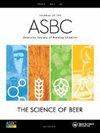Effects of Hydroxycinnamates and Exogenous Yeast Assimilable Nitrogen on Cider Aroma and Fermentation Performance
IF 1.8
4区 农林科学
Q4 BIOTECHNOLOGY & APPLIED MICROBIOLOGY
Journal of the American Society of Brewing Chemists
Pub Date : 2021-09-14
DOI:10.1080/03610470.2021.1968171
引用次数: 7
Abstract
Abstract Cider apple cultivars typically contain high concentrations of tannins (phenolic compounds) and/or acids. The phenolic content of some cider apples far exceeds that of white wine grapes, yet modern global cider styles are often fermented using yeast strains originally selected and commercialized for white wine production. The potential for phenolic compounds in cider apple juice to influence fermentation rate or aromas generated during cider fermentation is not typically considered in yeast strain selection. The objective of this study was to determine the impact of ferulic acid, p-coumaric acid, and chlorogenic acid (at concentrations reported in apples) on fermentation kinetics and cider aroma, and the interactive effects of yeast assimilable nitrogen (YAN) on these outcomes. Our hypothesis was that phenolic compounds present in high-tannin cider apples would slow down fermentation, but not alter aroma, and that added YAN would moderate these effects. Ferulic acid negatively affected fermentation performance , but p-coumaric and chlorogenic acids did not. A sensory sorting task showed that p-coumaric acid led to distinct differences in grouping by aroma, while ferulic acid resulted in distinct aroma descriptors. Finally, addition of YAN improved fermentation performance for low concentrations of ferulic acid, and it affected the aroma of cider amended with p-coumaric acid. Supplemental data for this article is available online at at [publisher’s weblink].羟基肉桂酸酯和外源酵母可同化氮对苹果酒香气和发酵性能的影响
苹果品种通常含有高浓度的单宁(酚类化合物)和/或酸。一些苹果的酚含量远远超过白葡萄酒葡萄,但现代全球苹果酒风格通常使用酵母菌株发酵最初选择和商业化的白葡萄酒生产。在选择酵母菌株时,通常不考虑苹果果汁中酚类化合物对发酵速率或苹果发酵过程中产生的香气的影响。本研究的目的是确定阿魏酸、对香豆酸和绿原酸(在苹果中报道的浓度)对发酵动力学和苹果酒香气的影响,以及酵母可同化氮(YAN)对这些结果的交互作用。我们的假设是,高单宁酸苹果中的酚类化合物会减缓发酵,但不会改变香气,而添加YAN会缓和这些影响。阿魏酸对发酵性能有负面影响,而对香豆酸和绿原酸对发酵性能没有负面影响。感官分类任务表明,对香豆酸导致了香气分类的明显差异,而阿魏酸导致了不同的香气描述符。最后,YAN的添加提高了低浓度阿魏酸的发酵性能,并影响了对香豆酸改性苹果酒的香气。本文的补充资料可在[出版商的网页链接]获得。
本文章由计算机程序翻译,如有差异,请以英文原文为准。
求助全文
约1分钟内获得全文
求助全文
来源期刊

Journal of the American Society of Brewing Chemists
工程技术-生物工程与应用微生物
CiteScore
4.00
自引率
20.00%
发文量
41
审稿时长
3 months
期刊介绍:
The Journal of the American Society of Brewing Chemists publishes scientific papers, review articles, and technical reports pertaining to the chemistry, microbiology, and technology of brewing and distilling, as well as the analytical techniques used in the malting, brewing, and distilling industries.
 求助内容:
求助内容: 应助结果提醒方式:
应助结果提醒方式:


